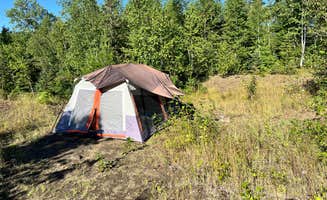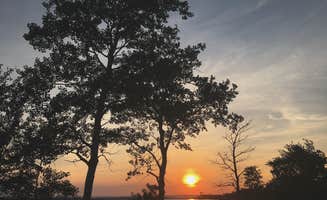Dispersed camping near Port Wing, Wisconsin offers varied terrain across forested public lands. Camping areas typically sit at elevations between 800-1200 feet with moderate temperature variations between day and night, even in summer. Most accessible sites require traveling unpaved roads ranging from well-maintained gravel to rough forest trails depending on seasonal conditions.
What to do
Mountain biking trails: The FlowMama Trail Head provides direct access to extensive bike networks. "Nice and quiet flat no facilities," notes Chris P., who appreciated the "small parking lot located off well-maintained gravel roads." Campers report excellent trail conditions for intermediate riders throughout summer and fall months.
Kayak launching: At Carrol Truck Trail, campers can access water entry points. "Upon reaching the end of the trail, there is a small dirt road that leads to a public Canoe/Kayak launch," reports Peter L., adding that while there are "no amenities, but you can filter your water." Morning paddles offer calmer conditions with less wind.
Stargazing opportunities: The remote location of most sites provides excellent night sky viewing. At State Land Lax Lake Area, visitors found ideal conditions for astronomy. One camper described their experience: "Had a fun night by the fire talking with the couple and looking at the stars. Overall very cool spot." Light pollution is minimal across most dispersed sites in the region.
What campers like
Natural seclusion: Castle Danger offers private camping spots surrounded by forest. "This area is definitely off the beaten path," writes Carissa J., noting the sites "appeared to not be visited often. I went in early August and a lot of the places were over grown with plants!" Many campers appreciate the privacy compared to developed campgrounds.
Wildflower viewing: Afterhours Meadow features seasonal blooms that transform the landscape. "This is a beautiful, quiet spot at the end of a forest spur road. Surrounded by wildflowers in mid July," reports Joni Z. The meadow provides open space for optimal sunrise and sunset viewing without obstruction.
Vehicle accessibility: Many sites accommodate various vehicle types despite rough conditions. Liona L. described Afterhours Meadow access: "Easy gravel road to the pin, there is one or two small sites on the left side of the road but we turned right and went down the 2 track (which was fine in 2wd vans w low clearance) and you end up in a big clearing." Most accessible sites require less than 5 miles of travel on unpaved roads.
What you should know
Wildlife encounters: Local forests host active wildlife populations that frequently interact with camping areas. At Carrol Truck Trail, Jasmine L. experienced: "Lots of wildlife for sure. But a pack of yoties or wolves was making our dog very alert they ran right next to us when we had our fire going." Keeping food secured is essential throughout the region.
Insect preparation: Mosquito populations can be extreme, varying by location and season. Anna P. described Carrol Truck Trail as "Very buggy (mosquitoes, ticks), no cell service." Another camper advised, "BRING BUG SPRAY! The mosquitoes are no joke." Head nets and permethrin-treated clothing provide additional protection during peak season.
Cell service limitations: Connectivity varies dramatically between sites. At Lake Superior Overlook, service tends to be more reliable due to elevation, while Mike B. reported "No facilities or cell service" at FlowMama Trail Head. ATT users report slightly better coverage than other carriers throughout the region.
Tips for camping with families
Weather preparation: Temperature fluctuations require planning appropriate gear. The area experiences significant overnight cooling even in summer months, with temperature drops of 15-20 degrees common. Dew formation occurs regularly in meadow areas, requiring waterproof ground cloths for tent camping.
Site selection: Look for established clearings with minimal undergrowth. A camper at Afterhours Meadow noted, "Nice little field. Would be great if the ground wasn't all sticks and thorns. Good place to sleep. Not for extended camping." Clearing small sticks before tent setup prevents punctures to sleeping pads.
Location access: Some sites require careful navigation and vehicle consideration. At State Land Lax Lake Area, a visitor observed "the driveway was overgrown and the clearing has lots of rocks and vegetation so glad I checked it out in the daytime." Arriving before sunset allows safer site evaluation and setup.
Tips from RVers
Parking surface conditions: Most dispersed sites have uneven ground requiring leveling equipment. Emma A. described Afterhours Meadow as a "Boondocking great spot! Drive back in to open field," though surface stability varies seasonally with spring months typically presenting muddier conditions requiring additional traction assistance.
Size limitations: Larger RVs face significant challenges at most dispersed sites. At Castle Danger, Sawyer P. warns: "DO NOT COME HERE UNLESS YOU HAVE A HIGH CLEARANCE 4x4. The 'road' up to the campsite is basically a jeep trail." Vehicles under 25 feet have more options throughout the region.
Resource planning: All dispersed sites require self-sufficiency for water and waste. Rick M. noted at FlowMama Trail Head: "Free parking, no water, no gray dump, no trash." Most campers bring 1-2 gallons of water per person per day plus additional water for cleaning and cooking purposes.




